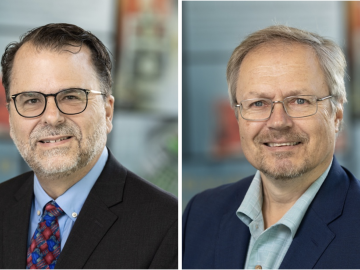
Filter News
Area of Research
- Advanced Manufacturing (22)
- Biology and Environment (41)
- Building Technologies (4)
- Clean Energy (171)
- Climate and Environmental Systems (1)
- Computational Biology (1)
- Computational Engineering (3)
- Computer Science (16)
- Electricity and Smart Grid (3)
- Functional Materials for Energy (1)
- Fusion and Fission (29)
- Fusion Energy (15)
- Isotopes (1)
- Materials (55)
- Materials for Computing (10)
- Mathematics (1)
- National Security (49)
- Neutron Science (24)
- Nuclear Science and Technology (15)
- Quantum information Science (6)
- Sensors and Controls (2)
- Supercomputing (116)
News Topics
- (-) 3-D Printing/Advanced Manufacturing (128)
- (-) Artificial Intelligence (102)
- (-) Buildings (67)
- (-) Computer Science (199)
- (-) Cybersecurity (35)
- (-) Fusion (59)
- (-) Grid (67)
- (-) ITER (7)
- (-) Machine Learning (51)
- (-) Security (26)
- Advanced Reactors (35)
- Big Data (62)
- Bioenergy (92)
- Biology (101)
- Biomedical (61)
- Biotechnology (24)
- Chemical Sciences (73)
- Clean Water (31)
- Climate Change (106)
- Composites (30)
- Coronavirus (46)
- Critical Materials (29)
- Decarbonization (85)
- Education (5)
- Element Discovery (1)
- Emergency (2)
- Energy Storage (112)
- Environment (201)
- Exascale Computing (44)
- Fossil Energy (6)
- Frontier (46)
- High-Performance Computing (94)
- Hydropower (11)
- Irradiation (3)
- Isotopes (57)
- Materials (149)
- Materials Science (149)
- Mathematics (10)
- Mercury (12)
- Microelectronics (4)
- Microscopy (51)
- Molten Salt (9)
- Nanotechnology (60)
- National Security (73)
- Net Zero (14)
- Neutron Science (139)
- Nuclear Energy (111)
- Partnerships (51)
- Physics (64)
- Polymers (33)
- Quantum Computing (38)
- Quantum Science (72)
- Renewable Energy (2)
- Simulation (53)
- Software (1)
- Space Exploration (25)
- Statistics (3)
- Summit (61)
- Sustainable Energy (130)
- Transformational Challenge Reactor (7)
- Transportation (99)
Media Contacts

A study led by the Department of Energy’s Oak Ridge National Laboratory details how artificial intelligence researchers created an AI model to help identify new alloys used as shielding for housing fusion applications components in a nuclear reactor. The findings mark a major step towards improving nuclear fusion facilities.

A new technical collaboration program at the Department of Energy’s Oak Ridge National Laboratory will help businesses develop and launch electric grid innovations. Sponsored by the Transformer Resilience and Advanced Components program in DOE’s Office of Electricity, the initiative will provide companies with access to national laboratory resources, enabling them to capture market opportunities.

U2opia Technology has licensed Situ and Heartbeat, a package of technologies from the Department of Energy’s Oak Ridge National Laboratory that offer a new method for advanced cybersecurity monitoring in real time.

Daryl Yang is coupling his science and engineering expertise to devise new ways to measure significant changes going on in the Arctic, a region that’s warming nearly four times faster than other parts of the planet. The remote sensing technologies and modeling tools he develops and leverages for the Next-Generation Ecosystem Experiments in the Arctic project, or NGEE Arctic, help improve models of the ecosystem to better inform decision-making as the landscape changes.

Stephen Kowalski and Mikael Salonvaara received the Distinguished Service Award, which salutes members who have served the society with distinction in chapter, regional and society activities.

Kashif Nawaz, distinguished researcher and section head for Building Technologies Research at the Department of Energy’s Oak Ridge National Laboratory, has been named a Fellow of the American Society of Mechanical Engineers, or ASME.

In a game-changing study, ORNL scientists developed a deep learning model — a type of artificial intelligence that mimics human brain function — to analyze high-speed videos of plasma plumes during a process called pulsed laser deposition.

Katy Bradford is on a mission to revolutionize the construction industry and is the founder of Cassette Construction, a company in the newest cohort of Innovation Crossroads, a DOE Lab-Embedded Entrepreneurship Program node at ORNL. As an Innovation Crossroads fellow, Bradford and her company will receive technical, financial and networking support to successfully advance the company’s products to the marketplace.

A new convergent manufacturing platform, developed in only five months at the Department of Energy’s Oak Ridge National Laboratory, is debuting at the International Manufacturing Technology Show, or IMTS, in Chicago, Sept. 9–12, 2024.

As high-tech companies ramp up construction of massive data centers to meet the business boom in artificial intelligence, one component is becoming an increasingly rare commodity: electricity. Since its formation in 2004, the OLCF has fielded five generations of world-class supercomputing systems that have produced a nearly 2,000 times reduction in energy usage per floating point operation per second, or flops. With decades of experience in making HPC more energy efficient, the OLCF may serve as a resource for best “bang for the buck” practices in a suddenly burgeoning industry.


